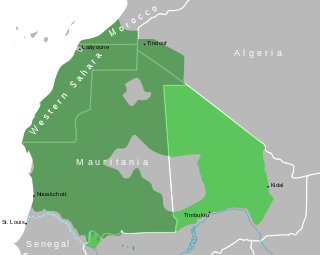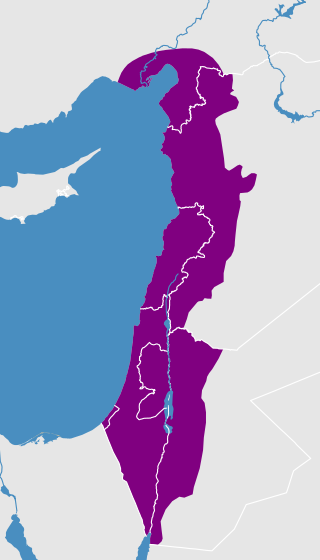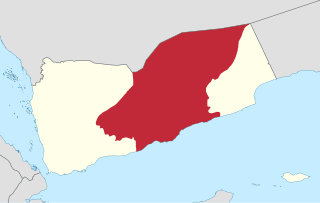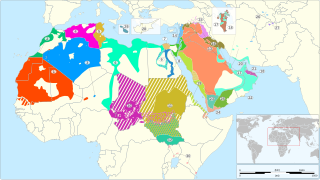| Khuzestani Arabic | |
|---|---|
| Native to | Iran |
Afro-Asiatic
| |
| Arabic alphabet | |
| Language codes | |
| ISO 639-3 | – |
| Glottolog | None |
Khuzestani Arabic is a dialect of Gelet (Southern) Mesopotamian Arabic spoken by the Iranian Arabs in Khuzestan Province of Iran. Whilst being a southern Mesopotamian Arabic dialect, it has many similarities with Gulf Arabic in neighbouring Kuwait. It has subsequently had a long history of contact with the Persian language, leading to several changes. [1] The main changes are in word order, noun–noun and noun–adjective attribution constructions, definiteness marking, complement clauses, and discourse markers and connectors. [1] [2]
Khuzestani Arabic is only used in informal situations. It is not taught in school, not even as an optional course, although Modern Standard Arabic is taught at a basic level for religious purposes. [1] Almost all Khuzestani Arabic speakers are bilingual in Arabic and Persian (the official language of Iran). [3] Khuzestani Arabic speakers are shifting to Persian; if the existing shift continues into the next generations, according to Bahrani & Gavami in Journal of the International Phonetic Association , the dialect will be nearly extinct in the near future. [3]
Khuzestani Arabic is spoken in Ahvaz, Hoveyzeh, Bostan, Susangerd, Shush, Abadan, Khorramshahr, Shadegan, Hamidiyeh, Karun, Martinica and Bawi. [3]
The Khuzestani Arabic dialect is in contact with Bakhtiari Lurish, Persian and Mesopotamian Arabic. [3] Although the lexis of the dialect is primarily composed of Arabic words, it also has Persian, English, French and Turkish loanwords. [3] In the northern and eastern cities of Khuzestan, Luri is spoken in addition to Persian, and the Arabic of the Kamari Arabs of this region is "remarkably influenced" by Luri. [3] In cities in Khuzestan such as Abadan, some of the new generations, especially females, often mainly speak Persian. [3] A number of Khuzestani Arabic speakers furthermore only converse in Persian at home with their children. [3]
Even in the most formal of conventions, pronunciation depends upon a speaker's background. [4] Nevertheless, the number and phonetic character of most of the 28 consonants has a broad degree of regularity among Arabic-speaking regions. Note that Arabic is particularly rich in uvular, pharyngeal, and pharyngealized ("emphatic") sounds. The emphatic coronals (/sˤ/, /dˤ/, /tˤ/, and /ðˤ/) cause assimilation of emphasis to adjacent non-emphatic coronal consonants.[ citation needed ] The phonemes /p/ ⟨پ⟩ and /v/ ⟨ڤ⟩ (not used by all speakers) are only occasionally considered to be part of the phonemic inventory, as they exist only in foreign words and they can be pronounced as /b/ ⟨ب⟩ and /f/ ⟨ف⟩ respectively depending on the speaker. [5] [6]
| Labial | Dental | Denti-alveolar | Palatal | Velar | Uvular | Pharyngeal | Glottal | |||
|---|---|---|---|---|---|---|---|---|---|---|
| plain | emphatic 1 | |||||||||
| Nasal | m | n | ||||||||
| Stop | voiceless | ( p ) | t | tˤ | k | ʔ | ||||
| voiced | b | d | dˤ | g | ||||||
| Fricative | voiceless | f | θ | s | sˤ | ʃ | x ~ χ | ħ | h | |
| voiced | ( v ) | ð | z | ðˤ | ɣ ~ ʁ | ʕ | ||||
| Affricate | voiceless | tʃ | ||||||||
| voiced | d͡ʒ | |||||||||
| Tap | ɾ | |||||||||
| Approximant | l | ( ɫ ) | j | w | ||||||
Phonetic notes:

Arabic is a Semitic language spoken primarily across the Arab world. Having emerged in the first millennium BC, it is named after the Arab people; the term "Arab" was initially used to describe those living in the Arabian Peninsula, as perceived by geographers from ancient Greece.

Khuzestan province is one of the 31 provinces of Iran. Located in the southwest of the country, the province borders Iraq and the Persian Gulf. Its capital is Ahvaz and it covers an area of 63,238 square kilometres (24,416 sq mi). Since 2014, it has been part of Iran's Region 4.

Hassaniya Arabic is a variety of Maghrebi Arabic spoken by Mauritanian Arabs and the Sahrawi people. It was spoken by the Beni Ḥassān Bedouin tribes of Yemeni origin who extended their authority over most of Mauritania and Morocco's southeastern and Western Sahara between the 15th and 17th centuries. Hassaniya Arabic was the language spoken in the pre-modern region around Chinguetti.
In Semitic linguistics, an emphatic consonant is an obstruent consonant which originally contrasted with series of both voiced and voiceless obstruents. In specific Semitic languages, the members of this series may be realized as uvularized or pharyngealized, velarized, ejective, or plain voiced or voiceless consonants. It is also used, to a lesser extent, to describe cognate series in other Afro-Asiatic languages, where they are typically realized as ejective, implosive, or pharyngealized consonants.

Ahvaz, or Ahwaz, is a city in the Central District of Ahvaz County, Khuzestan province, Iran. It serves as capital of the province, the county, and the district. It is home to Persians, Arabs, Bakhtiaris, Dezfulis, Shushtaris, and others. Languages spoken in the area include Persian, Arabic, Luri and dialects such as Bakhtiari, Dezfuli and Shushtari.

Levantine Arabic, also called Shami, is an Arabic variety spoken in the Levant: in Syria, Jordan, Lebanon, Palestine, Israel, and southern Turkey. With over 44 million speakers, Levantine is, alongside Egyptian, one of the two prestige varieties of spoken Arabic comprehensible all over the Arab world.
While many languages have numerous dialects that differ in phonology, the contemporary spoken Arabic language is more properly described as a continuum of varieties. This article deals primarily with Modern Standard Arabic (MSA), which is the standard variety shared by educated speakers throughout Arabic-speaking regions. MSA is used in writing in formal print media and orally in newscasts, speeches and formal declarations of numerous types.

Gulf Arabic is a variety of the Arabic language spoken in Eastern Arabia around the coasts of the Persian Gulf in Kuwait, Bahrain, Qatar, the United Arab Emirates, southern Iraq, eastern Saudi Arabia, northern Oman, and by some Iranian Arabs.
Libyan Arabic, also called Sulaimitian Arabic by scholars, is a variety of Arabic spoken in Libya, and neighboring countries. It can be divided into two major dialect areas; the eastern centred in Benghazi and Bayda, and the western centred in Tripoli and Misrata. The Eastern variety extends beyond the borders to the east and share the same dialect with far Western Egypt, Western Egyptian Bedawi Arabic, with between 90,000 and 474,000 speakers in Egypt. A distinctive southern variety, centered on Sabha, also exists and is more akin to the western variety. Another Southern dialect is also shared along the borders with Niger with 12,900 speakers in Niger as of 2021.

In Arabic and Maltese, the consonants are divided into two groups, called the sun letters or solar letters and moon letters or lunar letters, based on whether they assimilate the letter lām of a preceding Arabic definite article al- (الـ), which is an important general rule used in Arabic grammar. Phonetically, sun letters are ones pronounced as coronal consonants, and moon letters are ones pronounced as other consonants.
Baghdadi Arabic is the Arabic dialect spoken in Baghdad, the capital of Iraq. During the 20th century, Baghdadi Arabic has become the lingua franca of Iraq, and the language of commerce and education. It is considered a subset of Iraqi Arabic.
Kuwaiti is a Gulf Arabic dialect spoken in Kuwait. Kuwaiti Arabic shares many phonetic features unique to Gulf dialects spoken in the Arabian Peninsula. Due to Kuwait's soap opera industry, knowledge of Kuwaiti Arabic has spread throughout the Arabic-speaking world and become recognizable even to people in countries such as Tunisia and Jordan.

Hadhrami Arabic, or Ḥaḍrami Arabic (ḤA), is a variety of Arabic spoken by the Hadhrami people (Ḥaḍārem) living in the region of Hadhramaut in southeastern Yemen, western Oman and southern Saudi Arabia.
Taʽizzi-Adeni Arabic or Southern Yemeni Arabic is a dialect of Arabic spoken primarily in Yemen. The dialect itself is further sub-divided into the regional vernaculars of Ta’izzi, spoken in Ta'izz, and Adeni, spoken in Aden.
Bedouin Arabic refers to a typological group of Arabic dialects historically linked to Bedouin tribes, that has spread among both nomadic and sedentary groups across the Arab World. The group of dialects originate from Arabian tribes in Najd and the Hejaz that have spread since the 10th century until modern day. Bedouin dialects vary by region and tribe, but they typically share a set of features which distinguish them from sedentary-type dialects in each region.

Varieties of Arabic are the linguistic systems that Arabic speakers speak natively. Arabic is a Semitic language within the Afroasiatic family that originated in the Arabian Peninsula. There are considerable variations from region to region, with degrees of mutual intelligibility that are often related to geographical distance and some that are mutually unintelligible. Many aspects of the variability attested to in these modern variants can be found in the ancient Arabic dialects in the peninsula. Likewise, many of the features that characterize the various modern variants can be attributed to the original settler dialects as well as local native languages and dialects. Some organizations, such as SIL International, consider these approximately 30 different varieties to be separate languages, while others, such as the Library of Congress, consider them all to be dialects of Arabic.

Peninsular Arabic are the varieties of Arabic spoken throughout the Arabian Peninsula. This includes the countries of Saudi Arabia, Yemen, Oman, United Arab Emirates, Kuwait, Bahrain, Qatar, Southern Iran, Southern Iraq and Jordan.
Khuzestani Arabs are the Arabic speaking inhabitants of the Khuzestan province and the largest Arabic speaking community in Iran which primarily reside in the western half of Khuzestan. The capital of Khuzestan is Ahvaz. As of 2010, Khuzestani Arabs numbered around 1.6 million people.
The phonological system of the Hejazi Arabic consists of approximately 26 to 28 native consonant phonemes and 8 vowel phonemes:. Consonant length and vowel length are both distinctive in Hejazi.